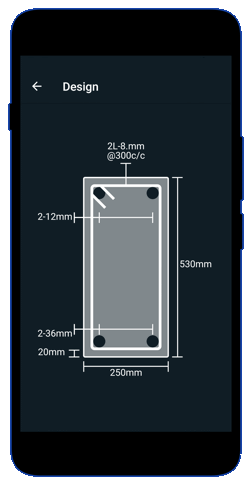To start the design of doubly reinforced beam you should have an idea about this type of section. As the name implies, in this type of beam section, we are providing the steel in both zones. In the case of a beam, the zone is basically compression and tension zone.
They are used in construction projects that require high load – bearing capacity, such as bridges, high – rise buildings. These beams allows for more efficient use of materials, as the additional steel provides added strength without the need for a larger c/s area. This can save on materials and construction costs. Furthermore, these beams are a practical solution for old structures, as they can be added to beams to increase their load bearing.
Check this post to know more about a doubly reinforced beam section.
As in this type of beams, the beam size is a constrain. Our main aim is only to calculate the area of reinforcement required in each zone of the beam section.
Procedure to design a doubly reinforced beam
The step by step procedure to design a beam section as per IS:456:2000 are as follows:
Calculate the depth of neutral axis.
Apply the equilibrium condition for the beam section. $$ C_{uc} +C_{us} = T_{u}$$
where Cuc and Cus are the compressive force in concrete and steel resp. and Tu is the tensile force in the steel.
The depth of neutral axis is $$ x_u = frac{f_{st} A_{st} – (f_{sc} – 0.447 f_{ck}) A_{sc}}{0.362 f_{ck} b} $$
Calculate the factored moment
In this case, we split the total bending moment into two parts.
$$M_u = M_{ur.max} + \Delta M_{u} $$
where Mur maxis the limiting moment capacity which is equal to the moment of resistance of a balanced RCC beam section and the second component is for the moment capacity which should be taken care by the compression reinforcement.
First calculate $$M_{ur.max} = R_{u.max} bd^2$$
If $M_u < M_{ur.max}$, obtain $A_{st}$ as of the SRB section (Check this post for the same), or else proceed to obtain $A_{st}$ as per the DRB section.
Design of reinforcement
Area of steel in tension zone is the sum of area of steel to resist the compressive and tensile forces in the tension zone. $$ A_{st } = A_{st1} + A_{st2} $$
$$A_{st1} = \frac{M_{ur.max}}{0.87f_y(d-0.42x_{u.max})}$$
$$A_{st2} = \frac{M_u – M_{ur.max}}{0.87f_y(d -d_c)}$$
Calculate the value of the area of steel in the compression zone using :
$$ A_{sc} =\frac{0.87 f_y A_{st2}}{(f_{sc}-f_{cc})} = \frac{0.87 f_y A_{st2}}{f_{sc}} $$
For HYSD bars obtain $f_{sc}$ corresponding $varepsilon_{s c}=0.0035left(1-frac{d_c / d}{k_{u cdot max }}right)$ from IS 456:2000.
This is not the end of the design procedure.
Then you have to check for shear reinforcement and deflection control of the RCC beam section. This part I have explained in this post.
Conclusions
In conclusion, designing a doubly R.C.C. beam section is a simple process that requires a thorough understanding of the Indian standard codes. Additionally, it is important to consider the potential for creep, and temperature effects when designing a doubly RCC beam. By following these steps, engineers can design a doubly R.C.C. beam section that is both efficient and effective.
In this post you have learned the following points:
- Importance of DRBs: In scenarios where the dimension of the beam is a constrain, it may be because of any reason (architectural or for head space), we have to go for these beams.
- Adhering to IS 456:2000: Following the Indian Standard code for R.C.C. design is imp. to ensure the integrity and safety of beams, as it is specific to the Indian context.
- Contribution to Safety: Properly designed beams leads to the overall safety, and durability of structures, and ensures the well being of users.
Check this post to know more about min. and max. steel of a beam section
Beam design
- RCC Beam Design is a free app for designing reinforced concrete beams as per Indian Standards.
- RCC Design and detailing could be performed by Limit State Method specified in IS456:2000
- Option to save the design projects in local storage.
- Detailed calculation steps presented for verification and validation.

This article was crafted by a group of experts at eigenplus to ensure it adheres to our strict quality standards. The individuals who contributed to this article are:
Author


